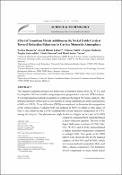Options
Effect Of Transition Metals Addition On The Nickel Oxide Catalyst Toward Reduction Behaviour In Carbon Monoxide Atmosphere
Journal
Pertanika Journal of Science and Technology
Date Issued
2023
Author(s)
Norliza Dzakaria
Azizul Hakim Lahuri
Fairous Salleh
Tengku Shafazila Tengku Saharuddin
Alinda Samsuri
Mohd Ambar Yarmo
DOI
10.47836/pjst.31.4.07
Abstract
The chemical reduction progression behaviour of transition metals (Mo, Zr, W, Ce, and Co) doped on NiO was studied using temperature programmed reduction (TPR) analysis. A wet impregnation method was applied to synthesise the doped NiO series catalysts. The reduction progress of the catalysts was attained by using a reductant gas at the concentration of 40% v/v CO/N2. X-ray diffraction (XRD) was employed to determine the composition of the reduced phases. Undoped NiO was reduced at 384℃ to obtain a cubic phase of NiO. It was observed that Ce/NiO exhibited the lowest reduction temperature of 370℃ among all catalysts. This phenomenon might be due to a higher surface area of Ce/NiO compared to undoped NiO, which facilitated a faster reduction reaction. The rest of the doped NiO series catalysts (Co/NiO, Mo/NiO, W/NiO and Zr/NiO) demonstrated a higher reduction temperature compared to undoped NiO. New peaks in the XRD pattern were observed only for the reduced catalysts of Mo/NiO and W/NiO, which were associated with monoclinic MoO2 and WO2.72 phases, respectively. The formation of new compounds or more stable nickel alloys led to a slower reduction reaction than undoped NiO. Therefore, Ce/NiO was the most efficient catalyst in promoting the formation of Ni under the CO atmosphere.
Subjects
File(s)
Loading...
Name
Effect of Transition Metals Addition on the Nickel Oxide Catalyst Toward Reduction Behaviour in Carbon Monoxide Atmosphere.pdf
Size
544.03 KB
Format
Adobe PDF
Checksum
(MD5):6be326d2232e9445be1ab03e9fc3b03a